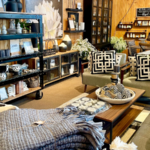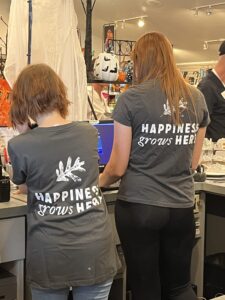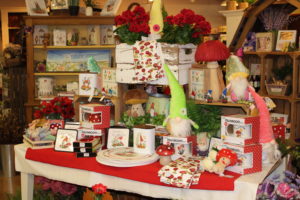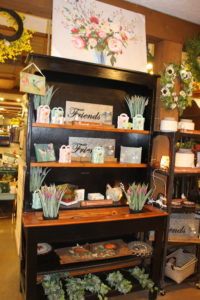Things Are Looking Up
Success in retail is predicated on the ability to compel the prospective customer to stop, look and buy. Throughout retail’s grand evolution, merchants have creatively enticed customers into their stores and through their selling environments. The primary goal shared by every retailer is to persuade the customer, appealing to their wants, needs and desires. Communication is an integral component of the retail process. We want to create a dialogue with customers and forge a relationship with them. Effective merchants will do more than just sell; they’ll teach and inform. Retail is a vibrant industry; it’s a bookmark of our society and a reflection of our times. It’s naturally the showplace for new ideas, new concepts and new products. The store environment is a critical component of the selling mechanism. It’s a selling stage for new products. It’s theater.
How do we strike up a dialogue with customers? How do we appeal to their aspirations? To begin, we must recognize that the well-designed retail environment is not merely a store, but rather an experience. When a customer crosses the threshold of the store, we want them to enter into another world our world. Once in our stores, we will speak to the customer through our architecture, floor fixtures, walls, graphics, interior décor and, most importantly, our merchandise. We must develop a proprietary language based on the culture of our store and the merchandise that we offer. The way we position the merchandise throughout the environment will determine how effectively we are communicating.
Laying the Foundation
Retail space can be manipulated to attract customer attention, direct customer movement and influence customer behavior. All shoppers exhibit similar and predictable responses to certain visual stimuli. As customers enter the store, they scan the environment and get an overall impression. As the eyes move across multiple visual planes, they stop at points defined by visual merchandising techniques. All of the effective techniques and philosophies of merchandise presentation and communication used by retailers are based on principles of perception and human behavior.
In terms of human behavior, surveys tell us that 80 percent of customers will turn to the right upon entering a store. This, combined with the aforementioned principle of perception, is an important piece of information to have when developing a store layout. It’s important to remember that customer service begins with a great floor plan. Effective store design leads customers through the store and helps them navigate the selling environment. A well-conceived floor plan directs the customer to where you want them to go. Controlled traffic flow is the most important tool at our disposal for gaining maximum merchandise exposure. If they turn to the right upon entering the store, position a vertical focal point at the end of the aisle or sight line. This will draw them forward. You are now moving them where you want them to go. As customers see these presentations, they approach them. They’ll meander or bounce from one presentation point to the next. These sequential points of travel are controlled by store designers and visual merchandisers.
Work Your Way Up
Vertical merchandising is a key component of a thriving retail environment. When presenting merchandise, we must maximize all visual opportunities. All too often, when designing a store, retailers think only in terms of square footage. But selling space should be thought of in terms of volume or cubic footage. Merchandise presentation is most effective when we consider it in three-dimensional terms. To intensify visual impact and make dynamic merchandise statements, consider the “airspace” above eye level. A flat sea of merchandise is unattractive and unappealing to the customer. Vertical merchandising moves the eye upward, unfolding new vistas and merchandise stories. It allows you to call out and showcase select classifications.
While we must use the vertical opportunities presented to us by existing architectural conditions, good judgment and a discerning eye are critical; retailers must choose their spots carefully. When setting up a selling floor, strive for an aesthetic balance between positive and negative space. Positive space is defined as the space occupied by merchandise on fixtures or walls. Negative space is the emptiness between fixtures and on walls, the airspace above fixtures and the space allocated to the aisles and entrance areas. Aesthetic balance between positive and negative space will create an atmosphere that welcomes the customer into the store and into each department.
Excessive vertical merchandising use of that upward positive space will create a warehouse-like atmosphere. But strategically positioning vertical presentations of merchandise throughout the space will have several constructive effects. First and foremost, vertical merchandising is a great attention-getter. Line movement implies direction and attitude. In artistic terms, vertical lines are eye-catching, powerful and bold, while horizontal lines are more casual, restful and relaxed. A vertical presentation makes a strong and compelling merchandise statement that is visible from a great distance. A vertical presentation will call out a classification of merchandise and differentiate it from other merchandise. A well-thought-out positioning of vertical presentations will clearly create interest on the selling floor. It will negate the ill effects of a flat and boring registration of merchandise.
Inject Life Into Displays
Today’s customers look beyond commodities and basic merchandise offerings. Wants become needs, and luxury goods become must-have items. This informed customer demands selection and quality. To fulfill these expectations, successful retailers place a great emphasis on compelling lifestyle presentations that show the merchandise as it’s intended to be used. Vertical merchandising is a great way to show lifestyle presentations and groupings of associated merchandise. It captures customer attention, captivates the imagination and encourages purchases. Furthermore, lifestyle presentations that tell the whole story combine classifications of merchandise, thereby promoting multiple sales.
Vertical merchandising and effective utilization of cubic footage plays an important role in promoting and assisting customer circulation to all parts of the store, exposing them to the full assortment of merchandise. To accomplish this, the store is divided into three specific merchandising zones:
The aisle zone. Fixtures in the aisle zone those closest to the viewer should have the lowest vertical profile of all the fixtures in the department. Fixtures in this zone welcome the customer into the department and announce the full assortment of merchandise housed in the bulk-of-stock and wall zones.
The bulk-of-stock zone. As the eye moves ahead toward the “bulk zone,” fixtures should be slightly higher. The bulk of stock is the mass-merchandise section of the selling floor that bridges the aisle and wall zones.
The wall zone. Moving further ahead, presentations on the wall should have the highest vertical profile within the department. This variation of fixture heights is known as the arena effect. It allows the merchant to fully utilize the cubic footage, enabling the customer to see all of the available merchandise.
When standing in front of the department, all zones are visible, transforming an otherwise static department into a dynamic selling space. Merchandise is more visible and more interesting. The customer is encouraged to spend more time shopping with a greater tendency to buy.
Up Against a Wall
When merchandising, never underestimate the power of the perimeter or the walls. Walls are effective and dynamic merchandising tools. They define the boundaries of an area while promoting and directing traffic flow. A strong vertical wall presentation will attract the customer’s eye from a considerable distance, enticing movement toward, into and through a department. Walls are important selling fixtures that present us with the opportunity to create focal points and vertical presentations of merchandise. Moreover, they are perfect vehicles to support both informational and environmental graphics, as well as merchandise-enhancing props. Consistent utilization of proven visual-merchandising techniques on wall presentations creates impact and strong merchandise statements. When creating a merchandise projection or display, the imaginary lines of a vertical triangular shape become the framework or guidelines for a powerful presentation format. This utilization of vertical space creates compelling, eye-catching presentations.
A wall, like the selling floor, also can be broken into three zones from floor to ceiling. Each zone of a wall presentation has a different impact on the viewer.
Zone one. On the lower portion of the wall, merchandise enters the field of vision only when the customer is directly in front of the elevation. Here, the full range of merchandise is readily accessible to customers at arm’s reach.
Zone two. On the middle section of the wall, merchandise is presented at eye level, in full range of the customer’s field of vision. Merchandise in this zone should communicate product detail and quality by highlighting and prominently displaying key items. This creates visual impact and places merchandise within easy access of the customer’s reach.
Zone three. On the upper section of the wall, we have the opportunity to communicate with customers from a great distance. The merchandise is typically beyond the customer’s reach but is highly visible upon entering the sales area. This zone is used for duplicate exposure by repeating bulk merchandise from the display above. Additionally, product information can be added in the form of lettering, graphics or actual product.
Mastering the Uphill Climb
One of the challenges for all retailers is to create order out of chaos. A retail environment, with its many product offerings and visual stimuli, can be overwhelming and intimidating to the customer. If the space lacks organization, it will not promote a positive shopping experience. The successful retailer understands that the store is a tool of communication. By controlling the physical environment and employing effective presentation techniques, we can convey quality messages to the targeted customer. Vertical merchandising speaks to the customer and draws them off the aisles and into the department. It maximizes space, promotes merchandise exposure and increases productivity.
SIDEBAR
How the Eye Works
With an understanding of the mechanics of our eyes, we know that the vertical image is dominant over the horizontal image. The field of vision of the human eye is analogous to the cone of light emitted by a flashlight. An area of concentrated viewing is located in the center of the field. The plane across the field of vision loses focus at the left and right edges.
The horizontal boundaries of the field of vision are referred to as peripheral vision. We discern images at the far edges of the field of vision, but must move our eyes or turn our heads to get them in focus. Because of this physical condition, vertical presentations are typically more interesting and effective than horizontal presentations. Vertical merchandising thus becomes an important presentation tool.


















 Videos
Videos





